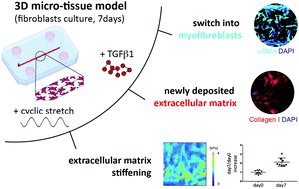A three-dimensional in vitro dynamic micro-tissue model of cardiac scar formation†
Abstract
In vitro cardiac models able to mimic the fibrotic process are paramount to develop an effective anti-fibrosis therapy that can regulate fibroblast behaviour upon myocardial injury. In previously developed in vitro models, typical fibrosis features were induced by using scar-like stiffness substrates and/or potent morphogen supplementation in monolayer cultures. In our model, we aimed to mimic in vitro a fibrosis-like environment by applying cyclic stretching of cardiac fibroblasts embedded in three-dimensional fibrin-hydrogels alone. Using a microfluidic device capable of delivering controlled cyclic mechanical stretching (10% strain at 1 Hz), some of the main fibrosis hallmarks were successfully reproduced in 7 days. Cyclic strain indeed increased cell proliferation, extracellular matrix (ECM) deposition (e.g. type-I-collagen, fibronectin) and its stiffness, forming a scar-like tissue with superior quality compared to the supplementation of TGFβ1 alone. Taken together, the observed findings resemble some of the key steps in the formation of a scar: (i) early fibroblast proliferation, (ii) later phenotype switch into myofibroblasts, (iii) ECM deposition and (iv) stiffening. This in vitro scar-on-a-chip model represents a big step forward to investigate the early mechanisms possibly leading later to fibrosis without any possible confounding supplementation of exogenous potent morphogens.



 Please wait while we load your content...
Please wait while we load your content...